Notes: The Stour Valley line was authorised under the London & Birmingham Railway & Canals Act of 1846. The increased threat of the new railway lines had made the canal owners wish to have a say in the construction and ownership of the fledgling rail network. On 18 July 1846 the London & Birmingham Railway (L&B), Grand Junction Railway (GJR) and Manchester and Birmingham Railway (MBR) merged to form the London & North Western Railway (LNWR). It would be this newly formed company which would go on to construct the Stour Valley line ensuring a more direct connection between the cities of Birmingham and Wolverhampton. Construction started in 1848 and the line was completed on 21 November 1851, with goods trains running from 1 February 1852. Passenger services began between Birmingham New Street and Wolverhampton on 1 July 1852 from a temporary platform at New Street, as the station was still under construction and would not be fully operational until 1 June 1854.
The second station was sited directly below the Icknield Street overbridge and comprised a single island platform situated between the up and down Stour Valley lines. Access to the platform was via steps directly from the street, and all buildings were at platform level. The main single-storey 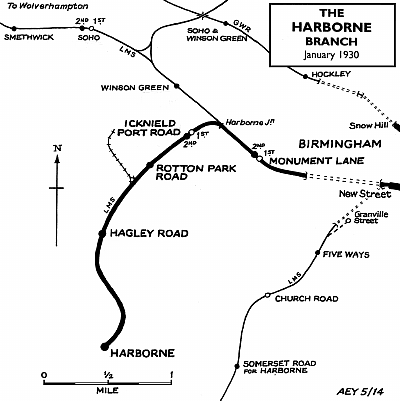 timber building was functional and unadorned, and the roof with a low-angled pitch extended on both sides to provide awnings; these carried deep valances with a simple scalloped pattern. A small timber shed with a pitched roof stood immediately north-west of the main building. The station would continue in its role as a ‘ticket platform’ for Birmingham New Street and by 1895 Bradshaw was showing there 51 up (Birmingham direction) services on Monday-to-Friday, with 50 on Saturday and 6 on Sunday. The vast majority of the weekday services terminated at Birmingham New Street, although nine continued through to London Euston. On Sunday three of the services terminated at New Street, with three continuing to Euston. In the down direction, the 1895 timetable shows 47 services on weekdays with destinations such as Chester, Crewe, Tipton and Wolverhampton. The largest proportion of down services was shown to Harborne, with a total of 19 on weekdays, giving rise to the station’s honorary title of the ’fifth station of the Harborne Branch’. timber building was functional and unadorned, and the roof with a low-angled pitch extended on both sides to provide awnings; these carried deep valances with a simple scalloped pattern. A small timber shed with a pitched roof stood immediately north-west of the main building. The station would continue in its role as a ‘ticket platform’ for Birmingham New Street and by 1895 Bradshaw was showing there 51 up (Birmingham direction) services on Monday-to-Friday, with 50 on Saturday and 6 on Sunday. The vast majority of the weekday services terminated at Birmingham New Street, although nine continued through to London Euston. On Sunday three of the services terminated at New Street, with three continuing to Euston. In the down direction, the 1895 timetable shows 47 services on weekdays with destinations such as Chester, Crewe, Tipton and Wolverhampton. The largest proportion of down services was shown to Harborne, with a total of 19 on weekdays, giving rise to the station’s honorary title of the ’fifth station of the Harborne Branch’.
| Up services December 1895 |
Destination |
Down services December 1895 |
Destination |
| 6.55am |
Birmingham New Street |
5.55am |
Chester |
| 7.05am |
London Euston |
6.59am |
Wolverhampton |
| 7.46am |
Birmingham New Street |
7.19am |
Harborne |
| 8.01am |
Birmingham New Street |
7.44am |
Soho Road |
| 8.21am |
Birmingham New Street |
7.59am |
Harborne |
| 8.36am |
Birmingham New Street |
8.09am |
Wolverhampton |
| 8.46am |
Birmingham New Street |
8.19am |
Wolverhampton via Bescot |
| 8.55am |
Birmingham New Street |
8.39am |
Wolverhampton |
| 9.06am |
Birmingham New Street |
9.12am |
Wolverhampton |
| 9.12am |
Birmingham New Street |
9.24am |
Harborne |
| 9.21am |
Birmingham New Street |
9.45am |
Wolverhampton via Bescot |
| 9.30am |
Birmingham New Street |
9.55am |
Crewe |
| 9.54am |
Birmingham New Street |
10.19am |
Harborne |
| 10.40am |
Birmingham New Street |
10.25am |
Dudley |
| 10.51am |
Birmingham New Street |
11.10am |
Wolverhampton |
| 10.56am |
Birmingham New Street |
12.09pm |
Wolverhampton |
| 11.05am |
Birmingham New Street |
12.19pm |
Harborne |
| 11.31am |
London Euston |
12.49pm |
Soho Road |
| 11.50am |
Birmingham New Street |
12.59pm |
Harborne |
| 12.51pm |
Birmingham New Street |
1.09pm |
Wolverhampton |
| 1.01pm |
Birmingham New Street |
1.19pm SX |
Harborne |
| 1.10pm |
Birmingham New Street |
1.20pm SO |
Harborne |
| 1.36pm |
Birmingham New Street |
2.11pm |
Wolverhampton |
| 1.53pm |
Birmingham New Street |
2.19pm |
Harborne |
| 2.12pm |
Birmingham New Street |
3.00pm |
Tipton |
| 2.21pm SX |
Birmingham New Street |
3.19pm |
Harborne |
| 2.50pm |
Birmingham New Street |
3.24pm |
Wolverhampton via Bescot |
| 3.01pm |
Birmingham New Street |
3.49pm |
Wolverhampton |
| 3.33pm |
London Euston |
4.24pm |
Harborne |
| 3.56pm |
Birmingham New Street |
5.09pm |
Wolverhampton |
| 4.00pm |
Birmingham New Street |
5.19pm |
Harborne |
| 4.06pm |
Birmingham New Street |
6.04pm |
Harborne |
| 4.41pm |
Birmingham New Street |
6.15pm |
Wolverhampton |
| 4.56pm |
Birmingham New Street |
6.29pm |
Harborne |
| 5.18pm |
London Euston |
6.45pm |
Wolverhampton |
| 5.30pm |
London Euston |
6.54pm |
Soho Road |
| 5.42pm |
Birmingham New Street |
7.19pm |
Harborne |
| 5.51pm |
Birmingham New Street |
8.01pm |
Chester |
| 6.26pm |
Birmingham New Street |
8.19pm |
Harborne |
| 6.31pm |
London Euston |
9.19pm |
Harborne |
| 7.01pm |
Birmingham New Street |
9.29pm |
Wolverhampton |
| 7.40pm |
Birmingham New Street |
9.44pm |
Soho Road |
| 8.01pm |
Birmingham New Street |
10.04pm |
Harborne |
| 8.20pm |
Birmingham New Street |
10.40pm |
Dudley |
| 8.56pm |
Birmingham New Street |
10.49pm |
Harborne |
| 9.10pm |
Birmingham New Street |
10.59pm |
Soho Road |
| 9.25pm |
Birmingham New Street |
11.20pm |
Chester |
| 10.01pm |
Birmingham New Street |
11.34pm |
Harborne |
| 10.33pm |
Birmingham New Street |
|
|
| 10.56pm |
Birmingham New Street |
|
|
| 11.22pm |
London Euston |
|
|
At the time of grouping on 1 January 1923, Monument Lane would come under the control of the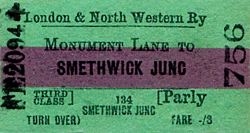 London Midland & Scottish Railway (LMS). With the closure of the Harborne Branch in 1934 the level of service was drastically reduced with the station losing around 20 trains per day in each direction. During the final year of the LMS control in 1947, the timetable shows 12 services on Monday-to-Friday, 15 on Saturday and three on Sunday in the Birmingham direction (up). In the down direction there were 11 services on Monday-to-Friday, 12 on Saturday and four on Sunday. On 1 January 1948 the station came under the control of the London Midland Region of British Railways (BR). The London Midland & Scottish Railway (LMS). With the closure of the Harborne Branch in 1934 the level of service was drastically reduced with the station losing around 20 trains per day in each direction. During the final year of the LMS control in 1947, the timetable shows 12 services on Monday-to-Friday, 15 on Saturday and three on Sunday in the Birmingham direction (up). In the down direction there were 11 services on Monday-to-Friday, 12 on Saturday and four on Sunday. On 1 January 1948 the station came under the control of the London Midland Region of British Railways (BR). The 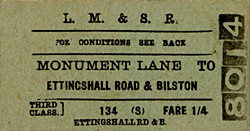 service under BR actually improved in the Wolverhampton (down) direction, with the 1956 LMS timetable showing 17 services on Monday-to-Friday with 15 on Saturday. In the opposite direction the level was pretty much the same as it was in 1947 with 11 services on Monday-to-Friday and 12 on Saturday. The most notable change was the withdrawal of the sparse Sunday service. It seems that BR did not install totem name signs at the station. service under BR actually improved in the Wolverhampton (down) direction, with the 1956 LMS timetable showing 17 services on Monday-to-Friday with 15 on Saturday. In the opposite direction the level was pretty much the same as it was in 1947 with 11 services on Monday-to-Friday and 12 on Saturday. The most notable change was the withdrawal of the sparse Sunday service. It seems that BR did not install totem name signs at the station.
| Up services 11 June to 16 September 1956 |
Destination |
Down services 11 June to 16 September 1956 |
Destination |
| 6.24am SX |
Coventry |
6.34am |
Stafford |
| 6.24am SO |
Birmingham New Street |
7.19am |
Stafford |
| 6.36am SX |
Birmingham New Street |
8.24am SX |
Walsall |
| 7.29am |
Birmingham New Street |
8.29am SO |
Walsall |
| 8.04am |
Birmingham New Street |
8.39am |
Wolverhampton |
| 8.46am |
Birmingham New Street |
10.30am |
Wolverhampton |
| 8.46am |
Rugeley Trent Valley |
12.19pm SO |
Wolverhampton |
| 9.28am |
Birmingham New Street |
1.09pm |
Wolverhampton |
| 1.05pm |
Birmingham New Street |
4.04pm |
Wolverhampton |
| 1.39pm SX |
Birmingham New Street |
5.05pm SX |
Wolverhampton |
| 1.47pm SO |
Birmingham New Street |
5.09pm SO |
Wolverhampton |
| 2.59pm |
Rugeley Trent Valley |
5.57pm SX |
Stafford |
| 5.00pm |
Birmingham New Street |
5.57pm SO |
Wolverhampton |
| 5.37pm |
Rugeley Trent Valley |
6.29pm |
Stafford |
| 6.12pm SX |
Birmingham New Street |
7.44pm SX |
Wolverhampton |
| 6.40pm SO |
Birmingham New Street |
7.49pm SO |
Wolverhampton |
| 6.42pm SX |
Birmingham New Street |
|
|
| 7.12pm |
Birmingham New Street |
|
|
| 7.36pm |
Birmingham New Street |
|
|
| 7.52pm SO |
Birmingham New Street |
|
|
| 11.15pm SX |
Birmingham New Street |
|
|
| 11.20pm SO |
Birmingham New Street |
|
|
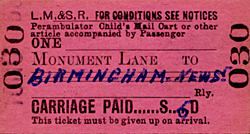 By the late 1950s the writing was on the wall for the station, with competition from buses and the affordability of the private motor car. BR announced the station would close during 1958 and there seems to have been little notable opposition to the closure. Monument Lane closed on 17 November 1958 and would be quickly demolished. By the late 1950s the writing was on the wall for the station, with competition from buses and the affordability of the private motor car. BR announced the station would close during 1958 and there seems to have been little notable opposition to the closure. Monument Lane closed on 17 November 1958 and would be quickly demolished.
Today there is little evidence of a station ever being at this location, with the Icknield Street overbridge having been widened to form Ladywood Middleway, wiping away any trace of the station entrance. A swathe of land is still apparent between the up main and the through siding where the platform once stood, which is the only evidence of note that a station was ever here.
Sources:
See also:
Monument Lane (1st), Icknield Port Road (1st), Icknield Port Road (2nd), Rotton Park Road, Hagley Road & Harborne
|

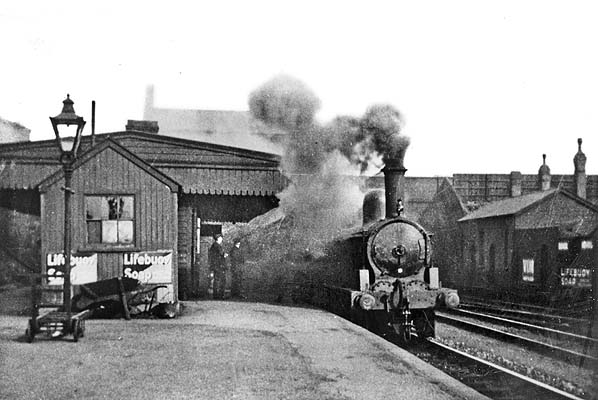
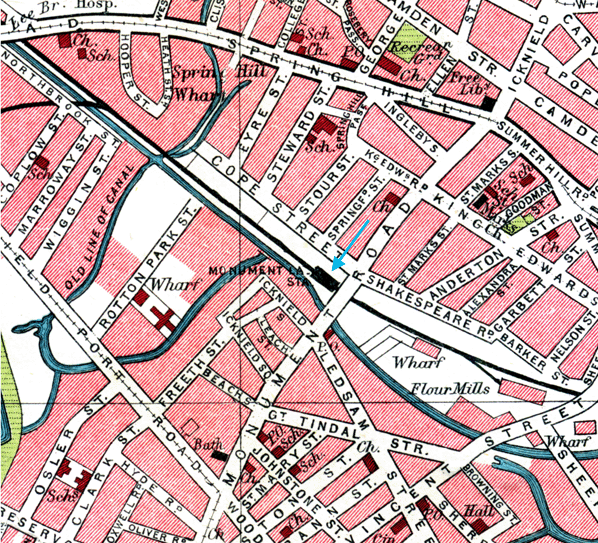
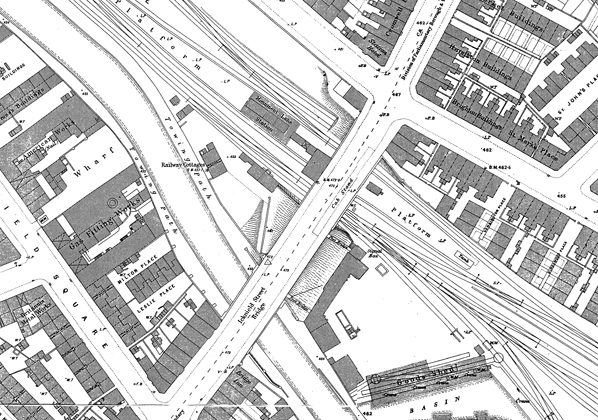
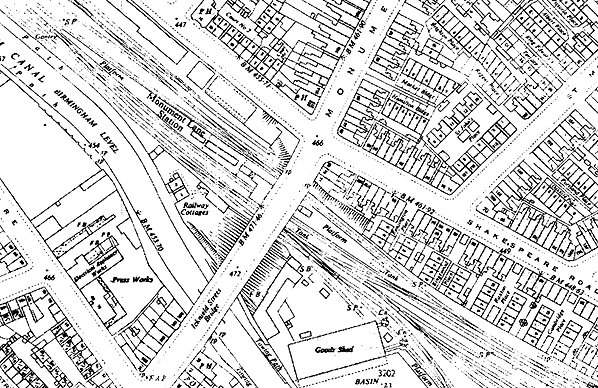



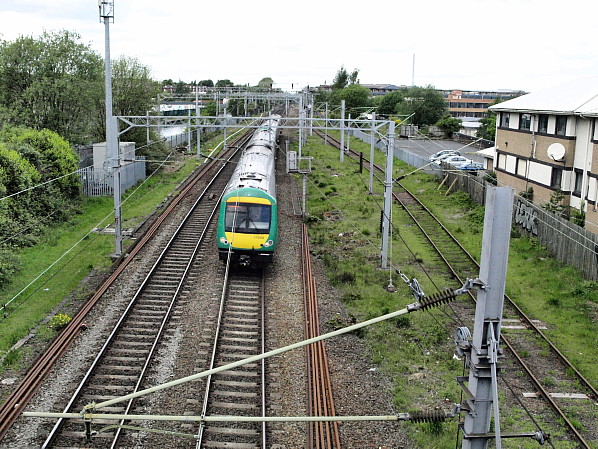
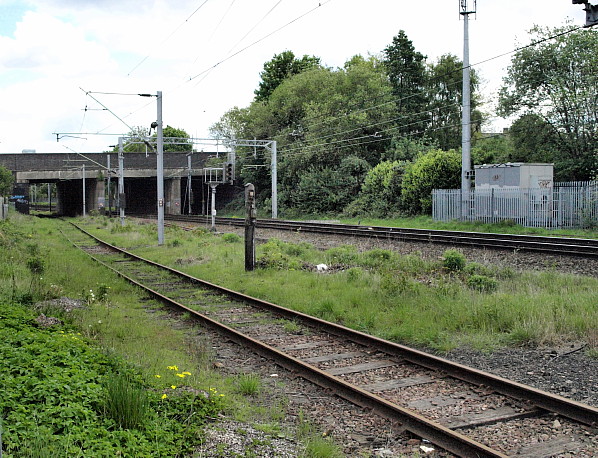
 timber building was functional and unadorned, and the roof with a low-angled pitch extended on both sides to provide awnings; these carried deep valances with a simple scalloped pattern. A small timber shed with a pitched roof stood immediately north-west of the main building. The station would continue in its role as a ‘ticket platform’ for Birmingham New Street and by 1895 Bradshaw was showing there 51 up (Birmingham direction) services on Monday-to-Friday, with 50 on Saturday and 6 on Sunday. The vast majority of the weekday services terminated at Birmingham New Street, although nine continued through to London Euston. On Sunday three of the services terminated at New Street, with three continuing to Euston. In the down direction, the 1895 timetable shows 47 services on weekdays with destinations such as Chester, Crewe, Tipton and Wolverhampton. The largest proportion of down services was shown to Harborne, with a total of 19 on weekdays, giving rise to the station’s honorary title of the ’fifth station of the Harborne Branch’.
timber building was functional and unadorned, and the roof with a low-angled pitch extended on both sides to provide awnings; these carried deep valances with a simple scalloped pattern. A small timber shed with a pitched roof stood immediately north-west of the main building. The station would continue in its role as a ‘ticket platform’ for Birmingham New Street and by 1895 Bradshaw was showing there 51 up (Birmingham direction) services on Monday-to-Friday, with 50 on Saturday and 6 on Sunday. The vast majority of the weekday services terminated at Birmingham New Street, although nine continued through to London Euston. On Sunday three of the services terminated at New Street, with three continuing to Euston. In the down direction, the 1895 timetable shows 47 services on weekdays with destinations such as Chester, Crewe, Tipton and Wolverhampton. The largest proportion of down services was shown to Harborne, with a total of 19 on weekdays, giving rise to the station’s honorary title of the ’fifth station of the Harborne Branch’.
 London Midland & Scottish Railway (LMS). With the closure of the Harborne Branch in 1934 the level of service was drastically reduced with the station losing around 20 trains per day in each direction. During the final year of the LMS control in 1947, the timetable shows 12 services on Monday-to-Friday, 15 on Saturday and three on Sunday in the Birmingham direction (up). In the down direction there were 11 services on Monday-to-Friday, 12 on Saturday and four on Sunday. On 1 January 1948 the station came under the control of the London Midland Region of British Railways (BR). The
London Midland & Scottish Railway (LMS). With the closure of the Harborne Branch in 1934 the level of service was drastically reduced with the station losing around 20 trains per day in each direction. During the final year of the LMS control in 1947, the timetable shows 12 services on Monday-to-Friday, 15 on Saturday and three on Sunday in the Birmingham direction (up). In the down direction there were 11 services on Monday-to-Friday, 12 on Saturday and four on Sunday. On 1 January 1948 the station came under the control of the London Midland Region of British Railways (BR). The  service under BR actually improved in the Wolverhampton (down) direction, with the 1956 LMS timetable showing 17 services on Monday-to-Friday with 15 on Saturday. In the opposite direction the level was pretty much the same as it was in 1947 with 11 services on Monday-to-Friday and 12 on Saturday. The most notable change was the withdrawal of the sparse Sunday service. It seems that BR did not install totem name signs at the station.
service under BR actually improved in the Wolverhampton (down) direction, with the 1956 LMS timetable showing 17 services on Monday-to-Friday with 15 on Saturday. In the opposite direction the level was pretty much the same as it was in 1947 with 11 services on Monday-to-Friday and 12 on Saturday. The most notable change was the withdrawal of the sparse Sunday service. It seems that BR did not install totem name signs at the station. By the late 1950s the writing was on the wall for the station, with competition from buses and the affordability of the private motor car. BR announced the station would close during 1958 and there seems to have been little notable opposition to the closure. Monument Lane closed on 17 November 1958 and would be quickly demolished.
By the late 1950s the writing was on the wall for the station, with competition from buses and the affordability of the private motor car. BR announced the station would close during 1958 and there seems to have been little notable opposition to the closure. Monument Lane closed on 17 November 1958 and would be quickly demolished.

 Home Page
Home Page